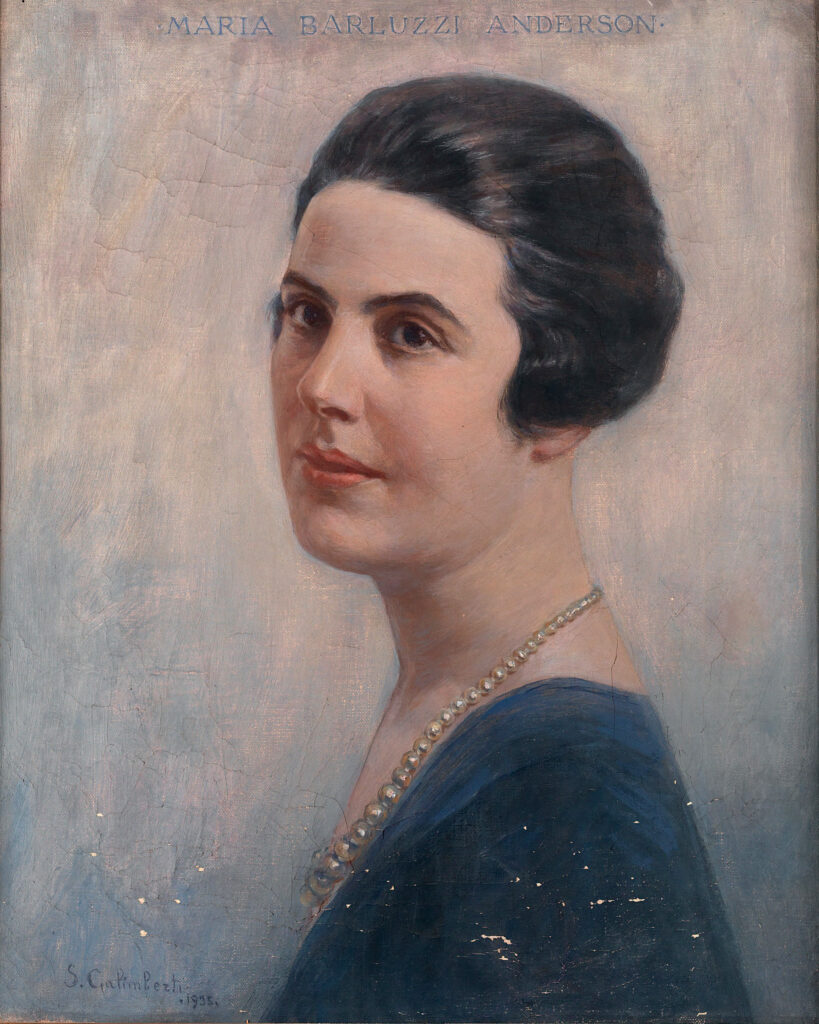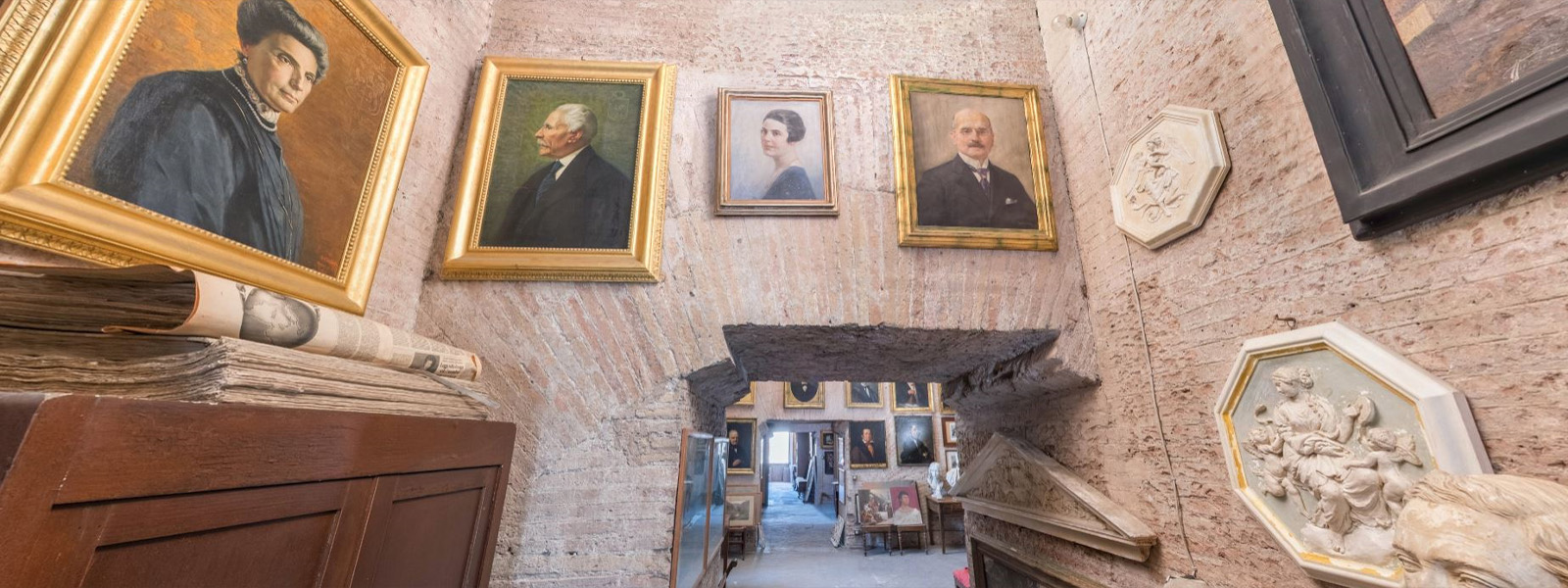The Anderson family
Maria Anderson, Giulio Barluzzi’s wife, belonged to an illustrious family of the Roman upper middle class well known all over the world, for its fine art photography catalogues.
Coming from Cumberland, England, under the name of Atkinson, this family was originally devoted to agriculture, as they were landowners. From John Atkinson and Hannah Topping the second son Isaac was born in Blencarn, on 11 March 1813. From a very young age he showed talent for painting and drawing. Isaac left his homeland to go to Paris, where he chose the stage name of William Nugent Dumbar. However, in 1838 he decided to move to Rome, where in 1839 he successfully participated, with three of his works, in the Annual Exhibition organized by the Society of Amateurs and Connoisseurs of Fine Arts.
The artistic environment and the charm of the eternal city helped to develop the artistic temperament of the young man even more, so as to convince him not to leave Rome anymore. It is in 1845 that, while continuing to cultivate painting, Isaac began to take an interest in photography, under the name of James Anderson between 1845 and 1846. James would immediately establish himself both in Italy and abroad as a talented photographer.
In 1851 he founded the prestigious photography house based in Fuori Porta del Popolo no. 19. In 1853 he definitively abandoned the art of painting to devote himself fully to the new art. In the same year James married Maria de Mutis and from their marriage 4 children were born.
It would be the eldest son Domenico (1854-1938) who successfully continued the activity made famous at a European level, by his father, in those years in which the photographic technique underwent so different and numerous innovations. This is what an article in Il Messaggero, on December 6, 1928, dedicated to Domenico Anderson “the father of photography” reported: “The oldest art photographer … among the best known and accredited ones… The Andersons represent a dynasty of photography artists, who from the way they bear fruit and add branches, one can believe that they will no longer perish.”
In 1878 he firstly married Vincenza Interlenghi, but because he was widowed after only a year, in 1881 he decided to marry the very young Clotilde Sardi who gave him nine children: Guglielmo (1882- 1912), Maria (1883-1935), Alessandro (1885-1973), Elisa called Lisetta (1887-1890), Sofia (1889-1975), Giorgio (1891-1986), Carolina called Lina (1894-1987), Enrico (1898-1938) and Roberto (1900-1938), all baptized into the Catholic religion.
Maria Barluzzi Anderson was portrayed by the well-known Roman painter Silvio Galimberti (1869 – 1956) in 1935 as shown by the date written in the lower margin of the painting (inv. 173), as the wife of the architect and engineer Giulio Barluzzi, who in 1939 would become President of the Pontifical Eminent Academy of Fine Arts and Letters of the Virtuous at the Pantheon.
An art scholar, her writings include studies on Pinelli (from 1927, quoted in Giulio Salvadori, Lettere (1907-1928) 1976, pp. 1005-1006) and on the Nazarenes (L’ultimo dei Nazareni, in “Rome”, II, 1924, p. 228-231).
Her beautiful portrait can be admired at the Pontifical Eminent Academy of Fine Arts and Letters of the Virtuous in the Pantheon. This Academy was founded in the 16th century and its purpose was that “of encouraging the study, exercise and improvement of Letters and Fine Arts and to promote the spiritual elevation of artists”. It was recognized by Pope Paul III on 5 October 1543.
The Academicians were “virtuosi”, that is, artists (painters, sculptors, architects). Among the first associates there were Taddeo Zuccari, Giacomo Barozzi da Vignola, Beccafumi, Antonio da Sangallo Junior and later the greatest artists and architects ever such as Pietro da Cortona, Rainaldi, Algardi, Borromini, Lanfranco, Preti, Velasquez, Juvarra, Vanvitelli, Valadier, Canova and many others.
Fifty ordinary papal Academicians distributed into five categories are now part of the Academy: Architects, Painters and Filmmakers, Sculptors, Musicians and Cultivators of the Arts, Writers and Poets, as well as 49 honorary Academicians.
Maria Anderson and Giulio Barluzzi welcomed exponents of the international artistic, cultural and social life of the early twentieth century, to their mansions in Rome and Ravello, establishing important relationships for exchanging ideas about taste, style and expression with the aristocratic, religious, political and intellectual personalities of the time.
Find out more:
https://it.gariwo.net/dl/Leonetti_definitivo_pdf.pdf
https://www.rerumromanarum.com/2019/10/villino-anderson.html
https://www.accademiavirtuosi.it/collezione/opera?id=173
https://www.accademiavirtuosi.it/collezione/virtualtour/#
The Andersons and the art of photography in Italy
This family originally came from England and for three generations they practiced the art of photography in Rome. The progenitor was Isaac Atkinson (Blencarn 1813-Rome 1877) who moved permanently to Rome in 1838 to devote himself first to painting and from 1845-1846 to photography, under the name of James – or Giacomo – Anderson. In 1859 he published his first printed catalogue and in 1877, on his death, he was a highly appreciated photographer in Italy and abroad. The business was inherited by his son, Domenico Anderson (Rome 1854–1938), who had already been working there for some time. In 1895 he obtained the patent for “a process and photographic apparatus for color reproduction”. With the help of his sons Guglielmo (1882-1912), Alessandro (1885-1973) and Giorgio (1891-1986), the business expanded and in 1907 they moved it to via Salaria, 7a. On this occasion the first general catalogue was printed. These would be years of great activity until 1957 when the company was forced to leave its historical headquarters and then until 1963, when it ceased its activity. Their archive would be purchased by Alinari (40,000 plates) and taken to Florence, but would be destroyed by the flood occurred there on November 4, 1966.
Catalogue of the Vatican Museums: the Andersons
The Anderson Fund of the Vatican Museums

Ritratto di Maria Barluzzi Anderson 1935
Olio su tela; cm 44 x 36
(con cornice: cm 55 x 46,5)
Firmato e datato in basso a sinistra:
S. Galimberti / 1935
Iscrizione, in alto a centro:
MARIA BARLUZZI ANDERSON ·
Inv. 173 PAVP, sede Pantheon




